ISLAMABAD (AP) – General Pervez Musharraf, who seized power in a bloodless coup and later led a reluctant Pakistan into the US war in Afghanistan against the Taliban, has died, officials said Sunday. He was 79 years old.
Musharraf, a former special forces commando, became president in the last round of a military coup that rocked Pakistan since its inception amid the bloody 1947 partition of India. He ruled the nuclear-armed state after his 1999 coup following tensions with India, a nuclear proliferation scandal and an Islamist extremist insurgency. He left office in 2008, facing possible impeachment.
In later life, Musharraf lived in self-imposed exile in Dubai to avoid criminal charges, despite attempting a political comeback in 2012. He maintained the fatalism of a soldier after narrowly escaping a violent death, which always seemed to follow him as Islamist terrorists twice targeted him for assassination.
Musharraf once wrote, “I have faced death many times in the past and challenged it because destiny and fate have always been kind to me.” “I only pray I have more than the proverbial nine lives of a cat.”
Musharraf’s family announced in June 2022 that he had been hospitalized in Dubai for weeks while suffering from amyloidosis, an incurable condition in which proteins build up in the body’s organs.
The family said, “going through a difficult phase where recovery is not possible and there is organ failure.” He later said he also needed access to the drug daratumumab, which is used to treat multiple myeloma. That bone marrow cancer can cause amyloidosis.
Shazia Siraj, a spokeswoman for the Pakistani consulate in Dubai, confirmed his death and said diplomats were providing assistance to his family. The Pakistan Army also expressed condolences.
A military statement said, “May Allah give peace to the departed soul and strength to the bereaved family.”
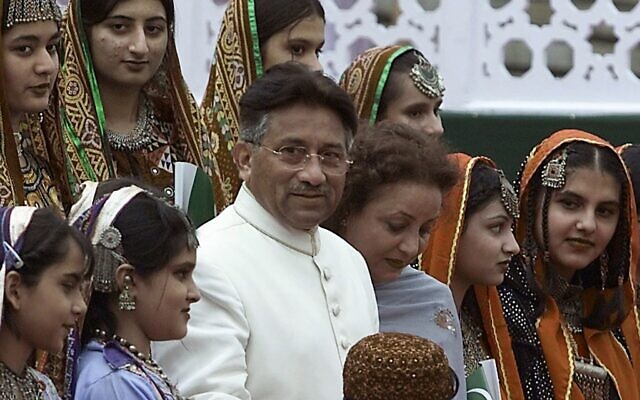
Pakistan’s President General Pervez Musharraf, center, and his wife Sahba Musharraf, third right, pose with Pakistani children in traditional costumes during the 54th anniversary celebrations of Pakistan’s Independence Day in Islamabad, Pakistan, August 14, 2001. (BK Bangash) / AP)
Pakistan, a country almost twice the size of California bordering the Arabian Sea, is now home to 220 million people. But it would be his border with Afghanistan that would soon attract US attention and dominate Musharraf’s life less than two years after he seized power.
Al-Qaeda leader Osama bin Laden launched the attack on September 11, 2001, from Afghanistan, which had been sheltered by the country’s Taliban rulers. Musharraf knew what would happen next.
He wrote in his autobiography, “America would surely react violently like a wounded bear.” “If the culprit turns out to be al-Qaeda, that wounded bear will come straight at us.”
By 12 September, then US Secretary of State Colin Powell told Musharraf that Pakistan would either be “with us or against us”. Musharraf said another US official threatened to “go back to the stone age” if Pakistan chose Pakistan.
Musharraf chose the former. A month later, he stood with then-US President George W. Bush at the Waldorf Astoria in New York and declared Pakistan’s unwavering resolve to fight with the United States against “terrorism in all its forms, wherever it exists”. There is support.
Pakistan became an important transit point for NATO supplies leading to besieged Afghanistan. This was the case even when Pakistan’s powerful Inter-Services Intelligence Agency supported the Taliban after they came to power in Afghanistan in 1994. Prior to this, the CIA and others provided money and weapons through the ISI to Islamic militias fighting the Soviet occupation of the 1980s. of Afghanistan.
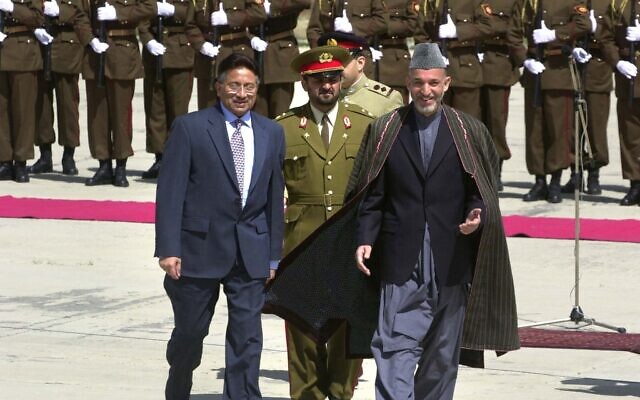
Interim Prime Minister of Afghanistan Hamid Karzai receives President of Pakistan General Pervez Musharraf at Kabul International Airport in Afghanistan April 2, 2002. (Suzanne Plunkett/AP)
The US-led invasion of Afghanistan saw Taliban fighters flee back to Pakistan across the border, including bin Laden, who the US would kill in 2011 at a compound in Abbottabad. They regrouped and the Pakistani Taliban emerged, beginning years of insurgency in the mountainous border region between Afghanistan and Pakistan.
The CIA began flying armed hunter drones out of Pakistan with Musharraf’s blessing, using an airstrip built by the founding president of the United Arab Emirates for falconry in Pakistan’s Balochistan province. The program helped repel militants, but more than 400 attacks in Pakistan alone killed at least 2,366 people — including 245 civilians, according to the Washington-based New America Foundation think tank.
Although Pakistan launched these operations under Musharraf, the militants flourished as billions of US dollars flowed into the nation. This created suspicions that still plague US relations with Pakistan.
“After 9/11, then-President Musharraf made a strategic shift to abandon the Taliban and support the US in the war on terror, but neither side believes the other has lived up to the expectations that flowed from that decision, Since then a 2009 US cable – published by WikiLeaks – said Ambassador Anne Patterson, which had become the diplomatic equivalent of a loveless marriage.
“The relationship is one of co-dependency that we reluctantly accept – Pakistan knows the US cannot walk away; America knows that Pakistan cannot survive without our support.
But it will be Musharraf’s life at stake. In 2003, terrorists tried to assassinate him twice by targeting his motorcade, first with a bomb placed on a bridge and then with a car bomb. In that second attack, Musharraf’s vehicle was lifted into the air by the explosion before touching the ground again. It only ran to safety on its rims, with Musharraf pulling a Glock pistol when needed to fight his way out.
It was not until his wife Sehba saw the car covered in gore that the scale of the attack dawned on her.
“She always remains calm in the face of danger,” he said. But then, “she was crying hysterically, uncontrollably.”
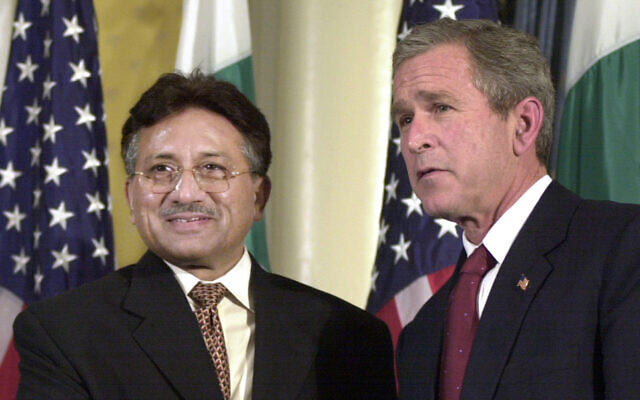
Then-US President Bush, right, shakes hands with then-Pakistani President Pervez Musharraf at a news conference at the Waldorf-Astoria Hotel in New York, Nov. 10, 2001. (Ed Bailey/AP)
Born on August 11, 1943, in New Delhi, India, Musharraf was the middle son of a diplomat. His family joined millions of other Muslims who migrated to the West when the predominantly Hindu India and Islamic Pakistan were partitioned during independence from Britain in 1947. Hundreds of people died in the riots and fighting in Partition.
Musharraf entered the Pakistan Army at the age of 18 and made a career there as Islamabad fought three wars against India. He began his attempt to seize territory in the disputed Himalayan region of Kashmir in 1999, just before seizing power from Prime Minister Nawaz Sharif.
Sharif had ordered Musharraf’s dismissal after the army chief had flown home from a visit to Sri Lanka and refused the right to land his plane in Pakistan even though it was low on fuel. On the ground, the army took control and after it landed, Musharraf assumed command.
Yet as ruler, Musharraf almost reached an agreement with India on Kashmir, according to American diplomats at the time. He also worked towards reconciliation with Pakistan’s longtime rival.
Another major scandal broke out during his rule when the world learned that the famous Pakistani nuclear scientist A.K. Dollar. Those designs helped Pyongyang arm itself with nuclear weapons, while centrifuges from Khan’s designs are still circulating in Iran amid the collapse of Tehran’s nuclear deal with world powers.
Musharraf said he suspected Khan, but it wasn’t until 2003 that George Tenet, then director of the CIA, showed him detailed plans for a Pakistani centrifuge the scientist was selling, which made him realize what had happened.
Khan confessed on state television in 2004 and was pardoned by Musharraf, although he was thereafter placed under house arrest.
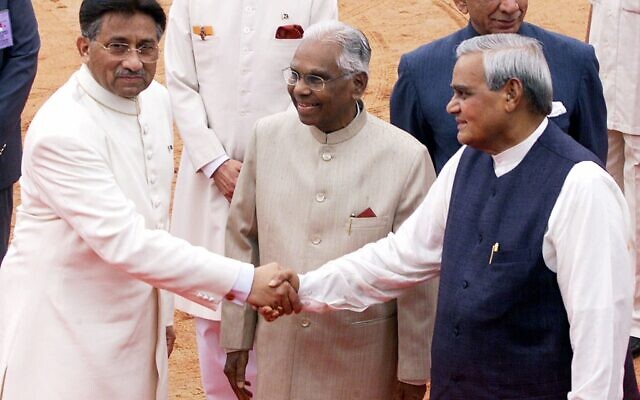
The then President of Pakistan General Pervez Musharraf is greeted by the then Indian Prime Minister Atal Bihari Vajpayee at the Rashtrapati Palace in New Delhi, India on July 14, 2001. (John McConico/AP)
Musharraf later wrote, “For years, stories of AQ’s lavish lifestyle and their wealth, property, corrupt practices and financial largesse at the state’s expense were generally well-known in Islamabad’s social and government circles.” “However, these were largely ignored. … In view of that neglect was evidently a grave mistake.
Musharraf’s domestic support eventually waned. He held flawed elections in late 2002 – only after changing the constitution to give himself sweeping powers to dismiss the prime minister and parliament. He then reneged on his promise to step down as army chief by the end of 2004.
Militant anger with Musharraf escalated in 2007 when he ordered a raid on the Red Mosque in the center of Islamabad. It had become a sanctuary for militants opposed to Pakistan’s support in the Afghan war. More than 100 people were killed in the week-long operation.
The incident severely damaged Musharraf’s reputation among everyday citizens and earned him the hatred of the militants, who launched a series of punitive attacks following the raid.
Fearing the judiciary, Musharraf removed the Chief Justice of the Supreme Court of Pakistan. This led to massive demonstrations.
Under pressure at home and abroad to restore civilian rule, Musharraf resigned as army chief. Although he won another five-year presidential term, Musharraf faced a major crisis following the assassination of former prime minister Benazir Bhutto at a campaign rally in December 2007 as he sought to become prime minister for a third time.
The public suspected Musharraf’s hand in the assassination, which he denied. A later United Nations report acknowledged that the Pakistani Taliban was a prime suspect in her assassination, but warned that elements of Pakistan’s intelligence services may have been involved.
Musharraf resigned as president in August 2008 after ruling coalition officials threatened to impeach him for imposing emergency rule and sacking judges.
Musharraf fought back his emotions and said, “I hope the country and the people will forgive my mistakes.”
Afterwards, he lived abroad in Dubai and London while attempting a political comeback in 2012. But Pakistan instead arrested the former general and put him under house arrest. He faced charges of treason over a Supreme Court defeat and other charges stemming from the Red Mosque raid and Bhutto’s assassination.
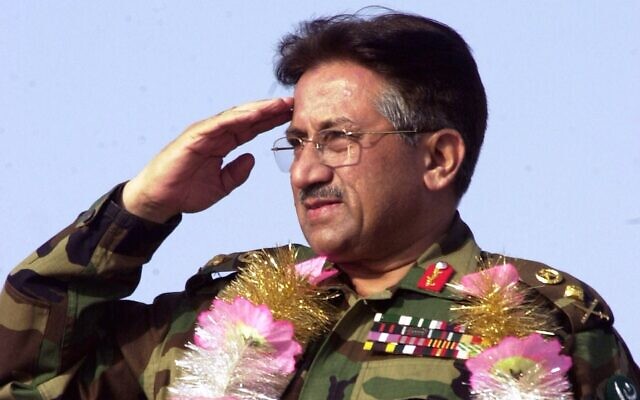
The then President of Pakistan, General Pervez Musharraf salutes a public rally in Lahore, Pakistan on April 9, 2002. (Zia Mazhar/AP)
Musharraf’s image of being treated as a criminal suspect shocked Pakistan, where military generals have long been considered above the law. Pakistan allowed him to leave the country on bail in Dubai in 2016 for medical treatment and later remained there after facing the death penalty.
But it suggested that Pakistan may be ready to turn a corner in its history of military rule.
The US ambassador at the time, Patterson, wrote, “Musharraf’s resignation is a sad but familiar story of pride, this time in a soldier who never made a good politician.”
“The good news is that the demonstrated strength of the institutions that toppled Musharraf – the media, free elections and civil society – also offer some hope for Pakistan’s future. It was these institutions that, ironically, were much stronger under his government. Have become.